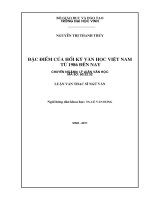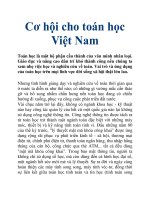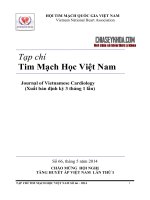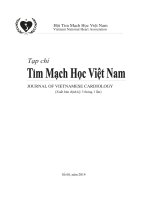Hội Tim mạch học Việt Nam
Bạn đang xem bản rút gọn của tài liệu. Xem và tải ngay bản đầy đủ của tài liệu tại đây (8.48 MB, 56 trang )
PCI for Chronic Total Occlusions
Suresh G. Vijan
MD., MRCP., FACC., FESC., FEISI.
Interventional Cardiologist
Lilavati and Fortis hospitals.
Mumbai., INDIA
NCC 2010
CTO Strategies
Principles of Technique
•
•
•
•
•
•
•
•
Contralateral angiography
Multiple views
Guiding catheter selection
Wire/device selection
Incremental stiffness (‟drilling‟) vs. „penetration‟
Parallel/Seesaw wiring, STAR
IVUS
Retrograde via collaterals, CART, Reverse CART
Success vs.
Complications
CTO lesion assessment
Proximal and distal caps.
Presence of micro channels.
Calcification at entry and distal caps.
Angulation and tortuosity.
Side branch relationship.
CTO length (>20 mm).
Presence and quality of collaterals.
Disease in donor and distal artery .
Donor and CTO vessel anatomy for guide and
guide wire selection.
NCC 2010
Angiographic Lesion Morphology
Tapered Stump Functional occlusion
Stump absent
Pre or
Bridging
Post-branch occlusion collaterals absent
Occlusion at
side-branch
Favor Procedural
Success
Total occlusion
Bridging
collaterals present
Does Not Favor
Procedural Success
Principles of CTO Revascularization
Advanced Strategies and Technique
Identification of the entry with IVUS
Distinguish false and true lumen
Contralateral angiography
Guiding catheter selection
Mother-in-Child Technique
Penetration vs Drilling
Parallel wire technique
Subintimal Tracking and Re-entry
Retrograde crossing
Kissing Wire
CART, Reverse CART,
Wire Externalization
Basic Concepts of Antegrade CTO PCI
• Antegrade Goal
Move gear safely
and quickly to
distal cap to focus
on true lumen entry
or…
Move gear beyond
distal cap to focus
on reentry
NCC 2010
Which wire and when?
Detailed study of cine angiogram- Microchannels present in 30-50% cases
Micro-channels visible
Plastic jacket or hydrophilic
wires
-Fielder XT, Fielder FC, & Fielder
-Pilot 50
-Terumo runthrough NS
Severe fibro calcific segment
Stiff extra support wires
-Miracle series 3, 4.5, 6, 12 gm
-Cross IT 100, 200, 300
-Intermediate wires
-Conquest pro, 8/12 gm
Always start with the soft wires as micro-channels are sometimes not visible and
quickly upgrade to stiffer wires in a step up strategy.
NCC 2010
CTO Guidewires – Tip Shaping
Primary bend ~ <30°
1-2mm from tip
Secondary
bend ~ 10-15°
NCC 2010
NCC 2010
PCI for CTO
When you can’t cross with wire
Advance
wire techniques.
Advance support with guides, mother and
child, anchor balloons, microcatheters.
IVUS guidance.
Switch to Retrograde approach.
NCC 2010
Antegrade CTO Wiring
Parallel wire technique
First wire
Second wire
NCC 2010
Anchor Technique
Transit
2.5x20mm balloon
Miracle 3g
Whisper MS
NCC 2010
Mother Child Support with Guideliner
Guide catheter
distal tip
GuideLiner
distal tip
NCC 2010
St. Jude Medical Venture Wire Control Catheter
NCC 2010
Antegrade CTO Wiring Techniques
IVUS guidance
Blunt occlusion at
sidebranch takeoff
IVUS in SB
Penetration
wire/technique
Confianza
IVUS probe
lumen proximal cap
CTO
distal cap lumen
Alternatively, PTCA balloon in SB to help
direct wire into proximal cap ---”open sesame”
NCC 2010
IVUS guidance in CTO
Distinguish false lumen fron true lumen
IVUS in
false lumen
True lumen
Guidewire
T. Suzuki, Toyohashi Heart Center
IVUS Guided Technique
for Finding the CTO Entry Point
CTO
*
Complex CTO
of MLCX
Where is the origin?
IVUS in
LA branch
NCC 2010
PCI for CTO
When you can’t cross with balloon.
Buddy
wire, Low profile balloons.
Guide support, anchor balloons.
Crossing devices
• Tornus catheter or Corsair/Fine cross
• Laser.
• Rotablator
Switch
to retrograde approach.
NCC 2010
ASAHI TORNUS™
© 2007 Abbott Laboratories
AP2925596 Rev. A
Asahi Corsair
For shaft rigidity
•After the screw head structure, the grade and the thickness of the polyamide
elastomer resin are gradually increased to provide optimal rigidity and pushability at
the proximal shaft.
Polyamide elastomer
© 2007 Abbott Laboratories
AP2925596 Rev. A
Mother-Child Catheter Technique
Camino 8Fr JR4.0
Heartrail 5Fr ST
Cypher 3.5x23mm
NCC 2010
Basic Steps in retrograde technique
Simultaneous bilateral angiograms.
Identify collateral channels.
Wiring and device tracking thru collateral
channel.
Reach the true lumen distal to CTO.
Cross the CTO – Direct/CART/ Reverse CART.
Retrograde wire in proximal segment.
Externalise the guide wire / antegrade wire.
Dilate and stent the CTO.
NCC 2010
Suitable equipment
Bi-femoral,
Bi-radial or Radio-femoral
approach.
7Fr/8Fr guides.
Short (90 cms) guide for donor artery.
Fielder FC, Fielder XT or stiffer wires.
Corsair or Fine cross catheters.
Appropriate anticoagulation (ACT>300).
Check every 30 mins.
NCC 2010









